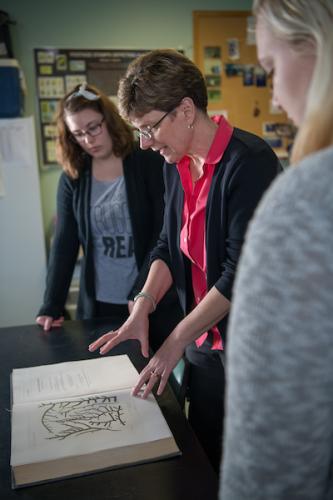
In the name of algae: OHIO researcher honored with namesakes

Morgan Vis is a professor in the Department of Environmental and Plant Biology and the associate dean for research, faculty and graduate studies in the College of Arts and Sciences. Her research in freshwater algae led to her recent publication of “Freshwater Red Algae” with cowriter Orlando Necchi Jr.
Vis enjoys the distinction of having two algae named for her: Anagnostidinema visiae sp. nov. (cyanobacteria), described by Dale Casamatta (PhD ‘02) and Sarah Hamsher (MS ’03) along with co-authors, and published in the Journal of Phycology; and a genus of freshwater red algae, Visia, named for her by her colleague Necchi with his students and published in Phytotaxa.
In honor of the International Day of Women and Girls in Science (February 11), we spoke to Vis about her career and experiences in the field.
Q: What interested you in a career in science?
A: I liked my science classes in K-12 and found chemistry, physics, math and biology all interesting.
Q: You’ve researched and published extensively on various kinds of algae, and your name is literally associated with two species. Why did you choose to study algae? What drew you to this particular organism?
A: I have always liked organisms that were unusual such as fungi, mosses, algae and small organisms that you could see in a microscope. I remember in high school biology being fascinated by the organisms swimming around from pond water.
Q: What are one or two decisions that you made during your career that had the most impact?
A: First decision, when I went to college I was given the advice that I should take a variety of first year science courses. That turned out to be good advice because I switched from chemistry to biological sciences because I was most interested in the great variety of organisms, how they interacted with their environment and why they occurred in one place and not another. Second was take advantage of opportunities: for example, studying abroad during college.
Q: You often involve students in your research, and your role as mentor has clearly had a far-reaching impact on their work. Why is it important for students to get hands-on experience in the field?
A: I always try to have undergraduates working with me. Undergraduates have lots of interests and it is valuable for them to explore what they like and do not like to move forward with their career path. Some of my students have decided to explore other areas of biology after working with me and other have gone on to careers in which they use their algae knowledge. Beyond conducting the research, most of my students present at [OHIO’s annual Student Expo (https://www.ohio.edu/studentexpo)]. This provides them skills in organizing their research into a poster and public speaking which are valuable in any career they wish to pursue.
Q: Why is algae important to both the world at large and the world of science?
A: Algae have numerous impacts both positive and negative. You may have heard of harmful algal blooms in marine and freshwater which are obviously negative. However, we use many types of algae as food or food additives such as nori, carrageenan, agar. The algae I study are the base of the food web in streams and are indicators of good water quality. The basic science that I do helps us understand algal species distributions, their life cycle and how many species and their relationship to each other.
Q: What’s a piece of advice that you would give to women and girls just starting out in this field?
A: In biology, there is still so much that is unknown which means there are opportunities to study anything that interests you.
Q: Is there anything else that you would like people to know about your research, being a woman in science, algae, etc.?
A: I feel very fortunate to be able to explore interesting research questions with outstanding undergraduate, graduate students and colleagues. In addition, to working with wonderful people at my university, I have been able to collaborate with researchers and students from Europe, South America, Africa and Asia. These international collaborations have allowed me to travel widely, meet new people and see amazing parts of the world.
